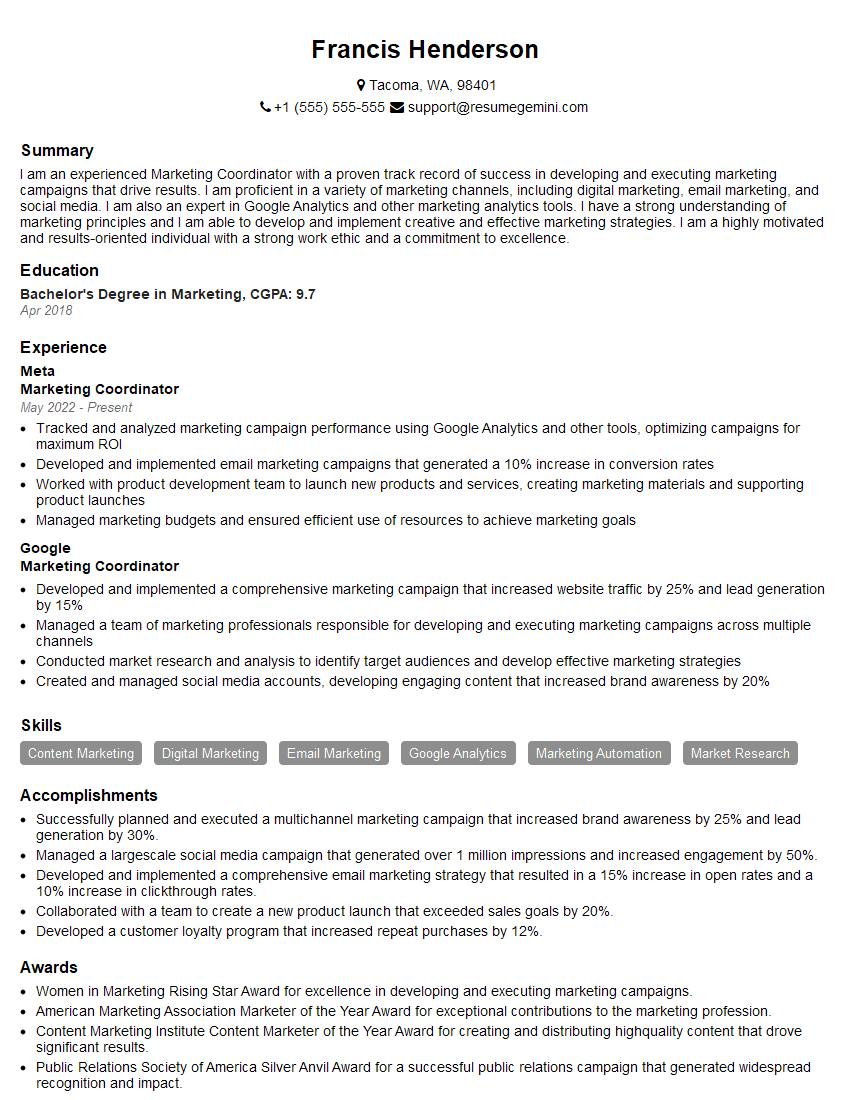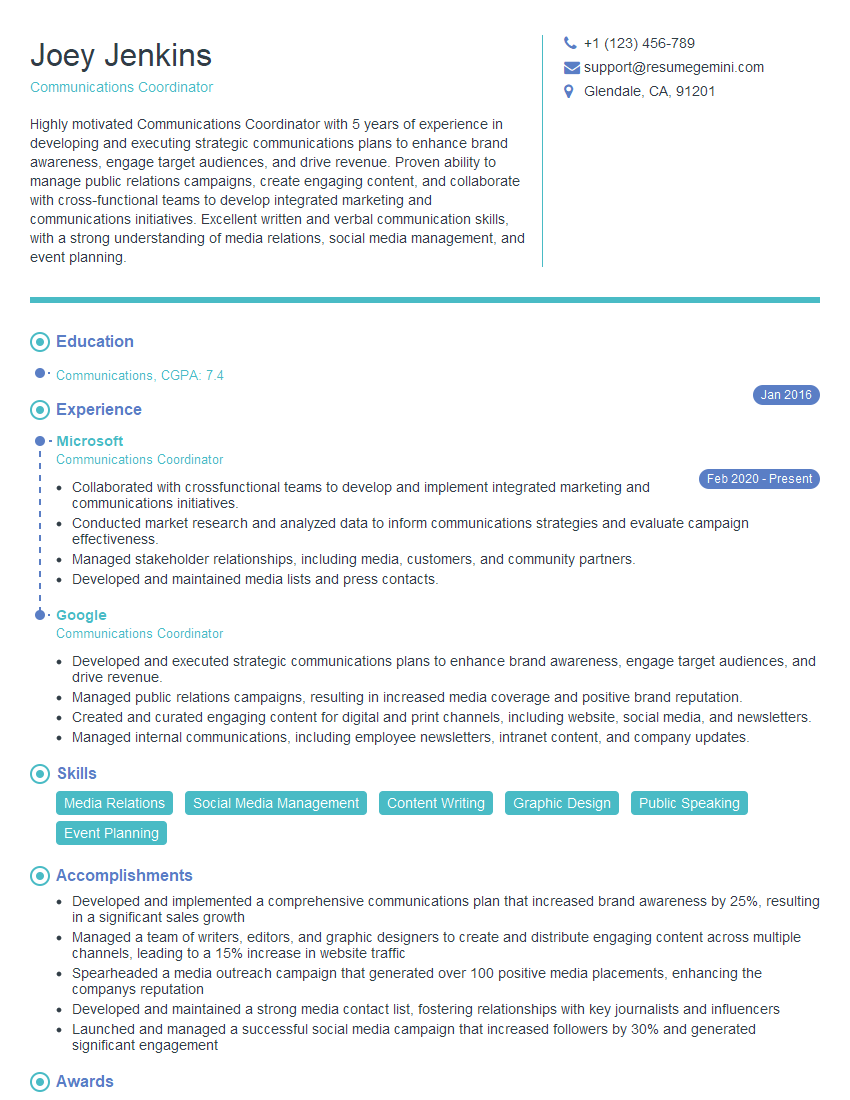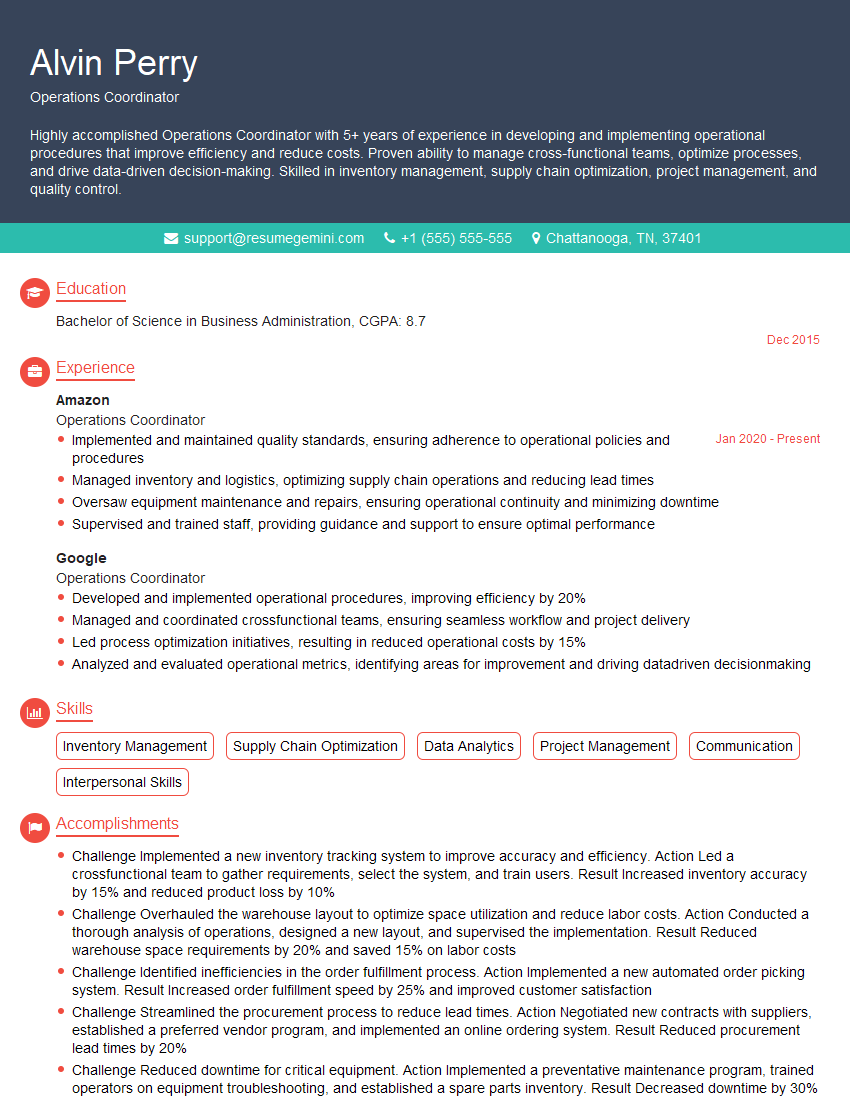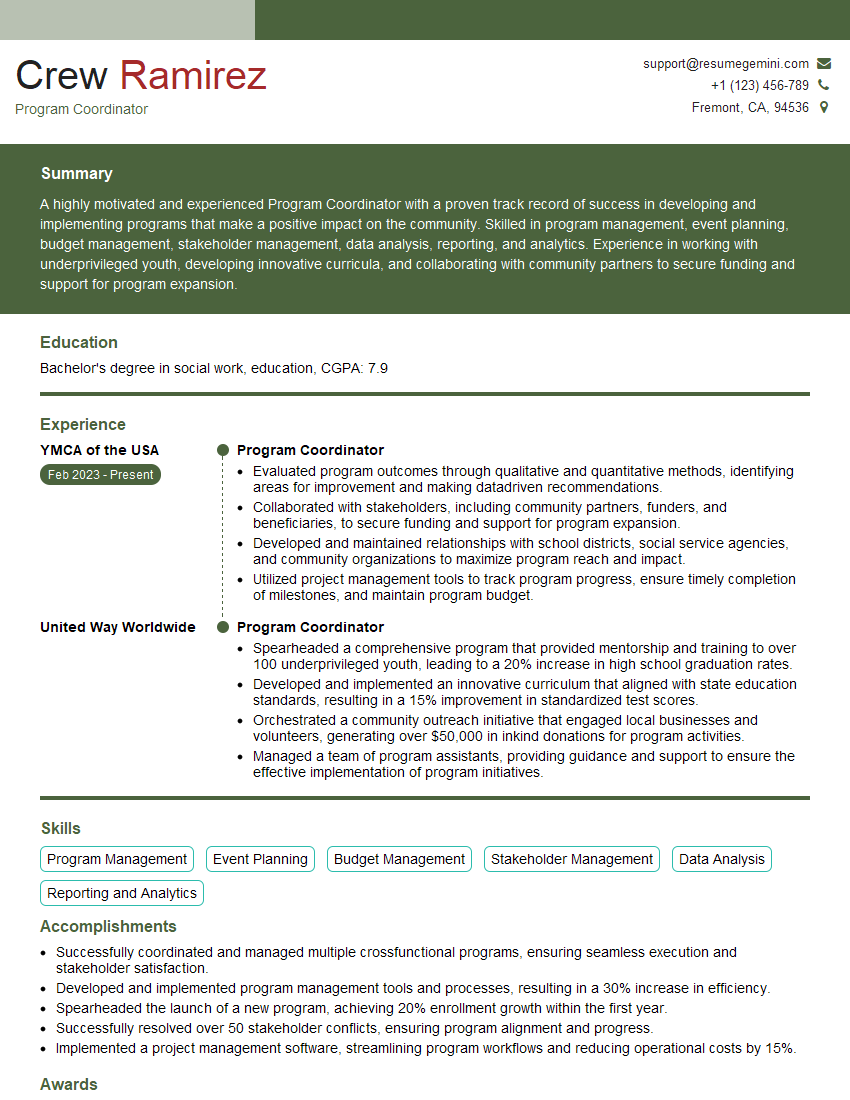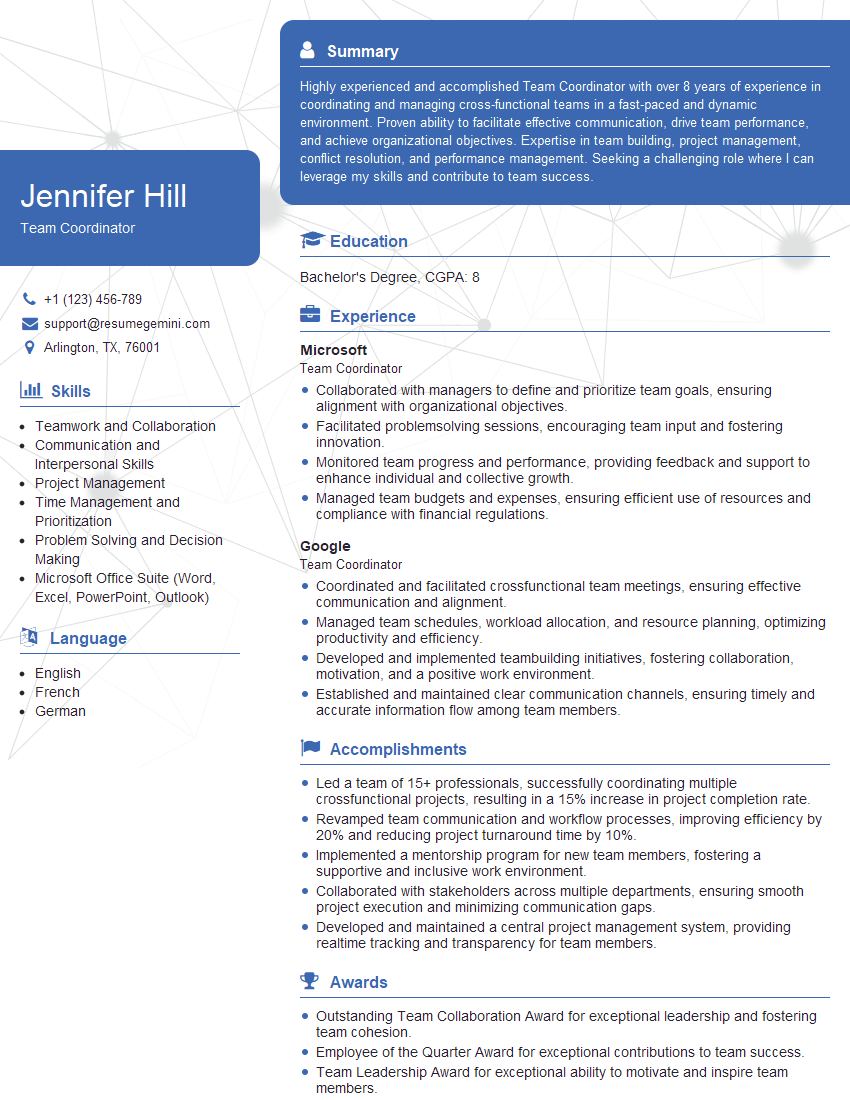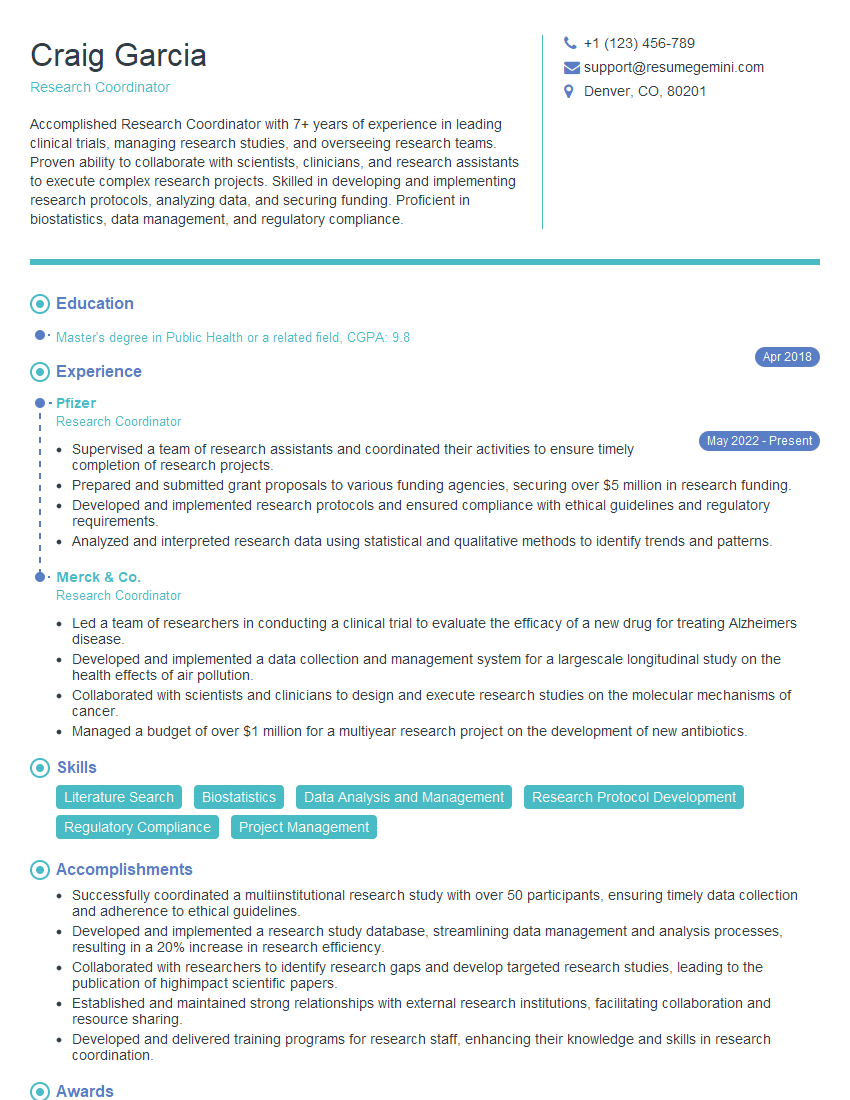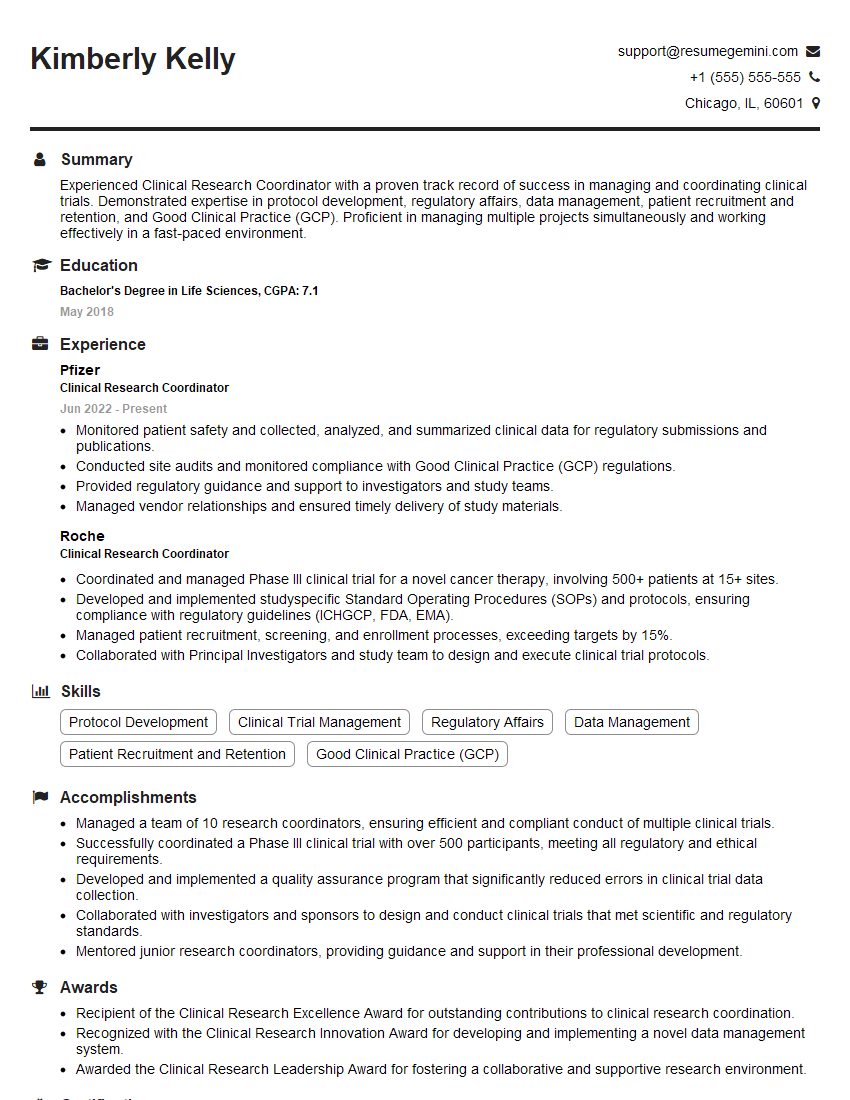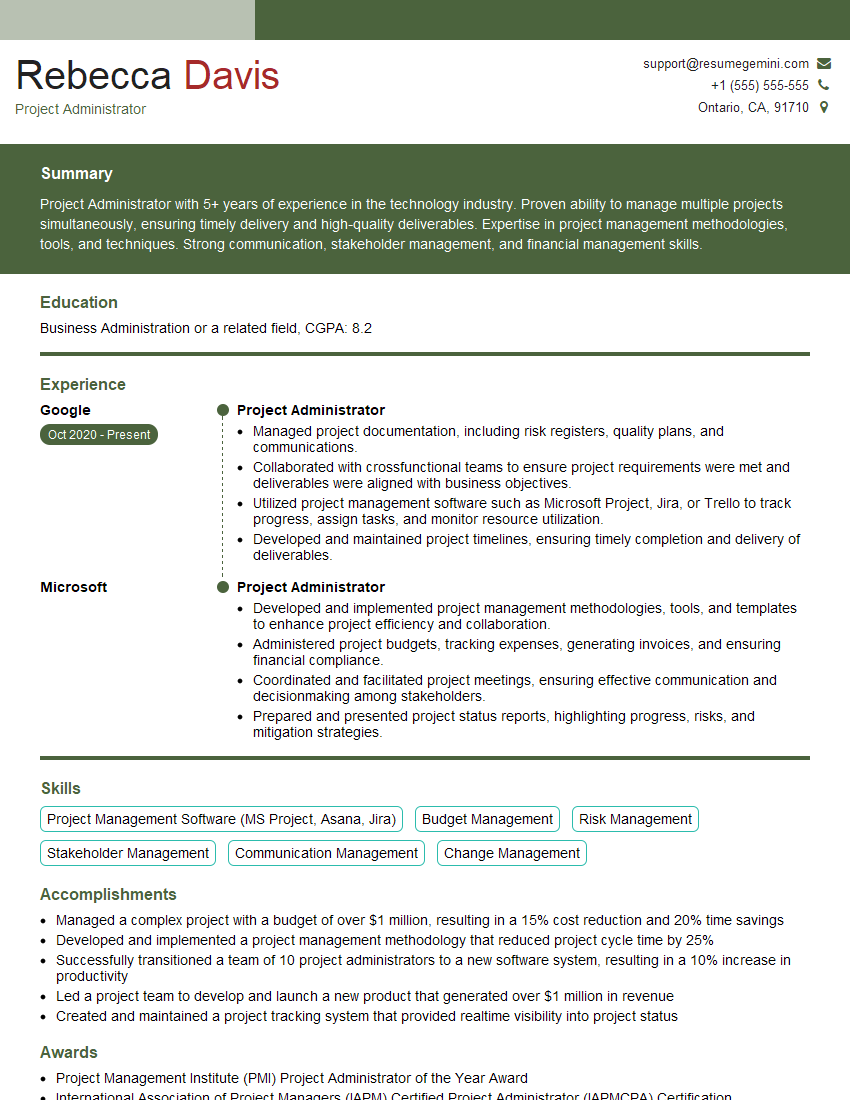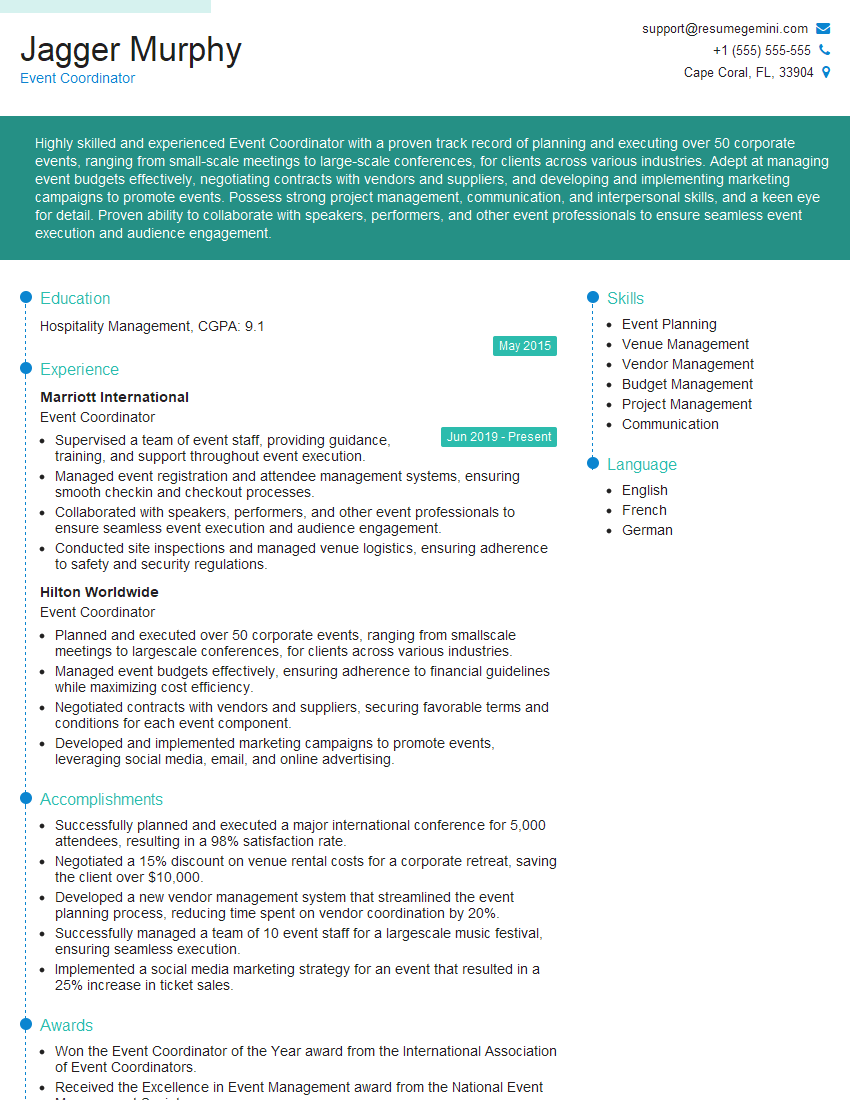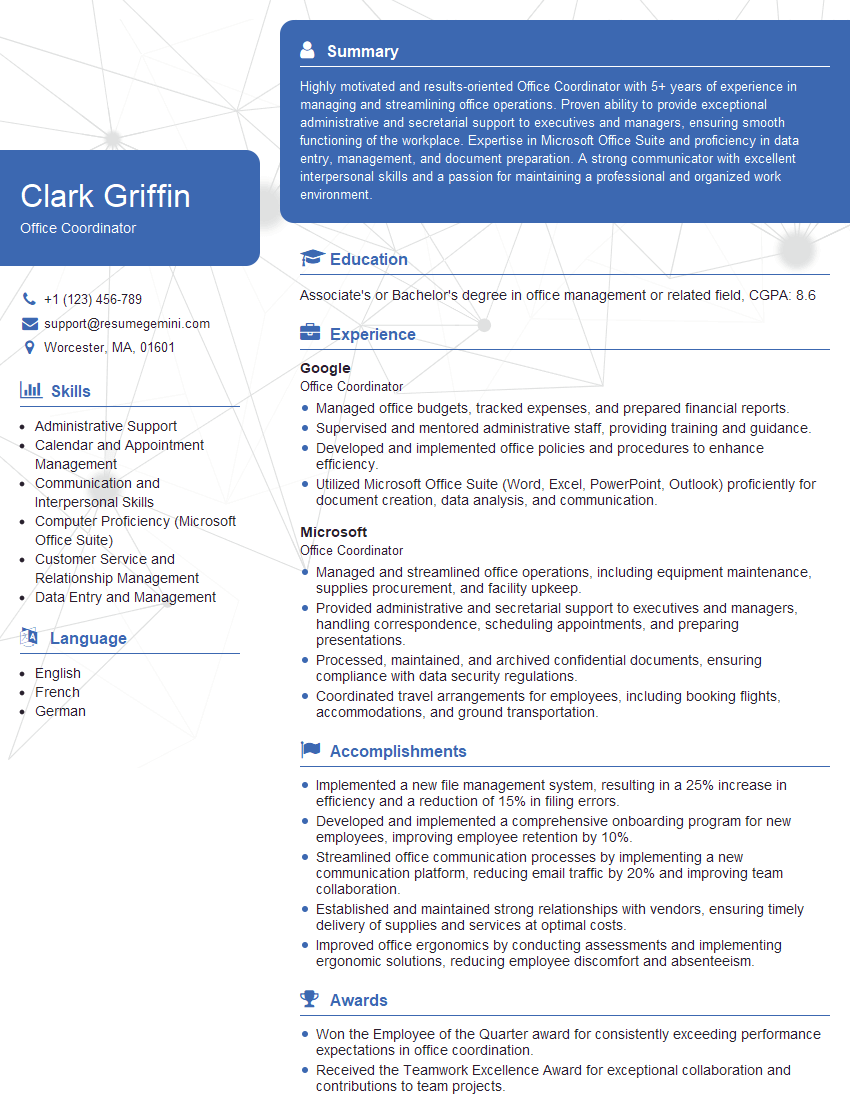Are you ready to stand out in your next interview? Understanding and preparing for Assisted with project coordination interview questions is a game-changer. In this blog, we’ve compiled key questions and expert advice to help you showcase your skills with confidence and precision. Let’s get started on your journey to acing the interview.
Questions Asked in Assisted with project coordination Interview
Q 1. Describe your experience assisting with project timelines and deadlines.
Assisting with project timelines and deadlines involves more than just looking at a calendar; it’s about proactive management and risk mitigation. My experience includes collaborating closely with project managers to establish realistic schedules, identifying potential bottlenecks, and developing contingency plans. I utilize Gantt charts and other visual aids to clearly illustrate tasks, dependencies, and deadlines. For instance, in a recent marketing campaign, I noticed a crucial design element was scheduled too close to the launch date. By highlighting this risk early, we were able to adjust the timeline, securing additional design resources, and preventing a delay.
I also track progress regularly, using project management software to flag any tasks falling behind schedule. This allows for early intervention, minimizing disruptions and ensuring timely project completion. This proactive approach avoids the last-minute scramble that often accompanies tight deadlines.
Q 2. How have you managed competing priorities in a project setting?
Managing competing priorities requires a systematic approach. I use prioritization matrices, such as Eisenhower’s Urgent/Important matrix, to categorize tasks based on their urgency and importance. This allows me to focus on high-impact tasks first, while delegating or deferring less critical items. For example, if a high-priority deadline is looming alongside several less urgent requests, I’ll prioritize the critical task, ensuring its timely completion, and then strategically allocate time for the others.
Open communication is key. I proactively communicate with stakeholders, clearly explaining the prioritization rationale and setting realistic expectations. This transparency avoids misunderstandings and maintains a positive working relationship, even when compromises are necessary.
Q 3. Explain your approach to organizing and prioritizing tasks within a project.
My approach to organizing and prioritizing tasks is based on a combination of visual tools and methodical strategies. I frequently employ Kanban boards, breaking down projects into smaller, manageable tasks. This allows for clear visualization of workflow and progress. Each task is assigned a priority level, typically using a system of high, medium, and low, based on factors such as deadline, impact, and dependencies.
Furthermore, I regularly review and re-prioritize tasks, adapting to changing project needs and emerging priorities. For instance, if a new high-priority task arises, I’ll reassess the existing task list and adjust accordingly. This ensures that resources are always focused on the most crucial aspects of the project.
Q 4. How do you track project progress and identify potential roadblocks?
Tracking project progress and identifying potential roadblocks involves a multi-pronged approach. I use project management software to monitor task completion rates, deadlines, and resource allocation. Regular status meetings with team members provide valuable insights into individual task progress and any challenges encountered.
Proactive identification of roadblocks involves actively looking for potential issues. This might involve reviewing task dependencies to anticipate potential delays or engaging in risk assessment exercises to identify and mitigate potential problems before they escalate. For example, if a team member consistently reports delays on a specific task, I would investigate the root cause, potentially involving additional resources or adjusting the task’s scope.
Q 5. What software or tools are you proficient in for project coordination?
I’m proficient in several project coordination software and tools, including Asana, Trello, Monday.com, and Microsoft Project. My experience with these tools extends to utilizing their features for task management, progress tracking, communication, and reporting. I am also comfortable using collaboration tools like Google Workspace (Docs, Sheets, Meet) for seamless team communication and document sharing.
My selection of tools is often dictated by the specific project’s needs and the preferences of the team. The most important aspect is choosing the tools that best support efficient collaboration and clear communication.
Q 6. Describe a time you had to troubleshoot a project-related issue.
In one project, we encountered a significant delay due to a third-party vendor failing to deliver crucial assets on time. My role involved immediate troubleshooting to minimize the impact on the project timeline. First, I contacted the vendor to understand the reason for the delay and explore possible solutions. Simultaneously, I communicated the issue to the project manager and other stakeholders, providing them with transparent updates.
We then explored alternative solutions, such as using readily available assets or commissioning a different vendor to complete the missing work. This proactive approach allowed us to minimize the delay and recover from the initial setback, demonstrating adaptability and resourcefulness.
Q 7. How do you ensure effective communication within a project team?
Ensuring effective communication within a project team is paramount. I prioritize regular updates and consistent feedback mechanisms. This includes scheduled status meetings, where team members can share updates, address challenges, and collaboratively solve problems. I also utilize instant messaging platforms for quick clarifications and updates, ensuring timely responses to queries.
Transparent communication is crucial. I strive to keep all stakeholders informed about project progress, potential risks, and any necessary changes. Open communication channels encourage collaboration and reduce the likelihood of misunderstandings, fostering a more efficient and productive project environment.
Q 8. How do you handle conflicts or disagreements within a project team?
Conflict resolution is crucial in project coordination. My approach focuses on understanding the root cause of the disagreement, fostering open communication, and finding mutually acceptable solutions. I begin by actively listening to each party involved, ensuring everyone feels heard and understood. This often involves asking clarifying questions to uncover the underlying concerns. Once the issue is clear, I facilitate a collaborative discussion, encouraging everyone to brainstorm potential solutions.
For example, on a recent project, two team members disagreed on the best approach to a technical challenge. Instead of imposing a solution, I organized a meeting where they could present their perspectives and discuss the pros and cons of each approach. Through this collaborative process, they reached a consensus that incorporated the best elements of both ideas. If a consensus can’t be reached, I’ll escalate the issue to the project manager, ensuring transparency and fairness throughout the process. The key is to focus on finding a solution that benefits the project as a whole.
Q 9. What is your experience with project documentation and reporting?
Meticulous documentation and reporting are fundamental to successful project coordination. My experience encompasses creating and maintaining various project documents, including project plans, meeting minutes, risk registers, and progress reports. I use a combination of tools and techniques depending on the project’s requirements and team preferences. This includes utilizing project management software like Asana or Jira for task tracking and collaboration, and Microsoft Office Suite (Word, Excel, PowerPoint) for formal reports and presentations.
For instance, I developed a standardized reporting template that provided a clear, concise overview of project status, key milestones achieved, and any identified risks. This ensured consistent reporting and facilitated timely decision-making by the project stakeholders. I also maintain version control on all documents to ensure clarity and avoid confusion. I believe clear and consistent reporting significantly contributes to project transparency and success.
Q 10. How do you contribute to a positive and productive project environment?
Creating a positive and productive environment is paramount for efficient project coordination. I contribute to this through proactive communication, fostering teamwork, and promoting a culture of mutual respect. I regularly hold team check-in meetings not just to discuss progress but also to address any concerns or challenges. This open communication allows early identification and resolution of issues before they escalate. I actively encourage collaboration and knowledge sharing among team members.
For example, I’ve organized team-building activities (both virtual and in-person) to enhance camaraderie and improve team cohesion. Recognizing individual contributions and celebrating achievements also plays a vital role in creating a positive team dynamic. A positive and collaborative atmosphere leads to increased motivation, improved efficiency, and ultimately, a higher-quality project outcome.
Q 11. Describe your experience with budget management in project coordination.
Budget management is an integral part of project coordination. My experience includes tracking project expenses against the approved budget, identifying potential cost overruns, and proposing mitigation strategies. I utilize spreadsheets or project management software to meticulously track all costs, regularly comparing them against the allocated budget. I proactively monitor expenses and flag potential overruns to the project manager, suggesting cost-saving measures where possible.
In one project, we identified a potential cost overrun due to unexpected delays. By analyzing the budget and collaborating with team leads, I proposed alternative solutions, such as negotiating better rates with vendors or re-allocating resources. This proactive approach helped avoid significant cost overruns and kept the project on track.
Q 12. How do you prioritize tasks when faced with multiple urgent requests?
Prioritizing tasks effectively is essential, especially when faced with competing demands. I employ a prioritization framework that combines urgency and importance. I use methods like the Eisenhower Matrix (Urgent/Important), which categorizes tasks into four quadrants: Do, Decide, Delegate, and Delete. This helps to focus my efforts on the most crucial tasks first.
For example, if I receive multiple urgent requests, I’ll first assess each request’s impact on the project’s overall goals. High-impact, urgent tasks get immediate attention. Tasks that are important but not urgent are scheduled. Tasks that are neither urgent nor important are often delegated or eliminated altogether. Clear communication is key—I inform those who submitted the requests about the prioritization and expected timeline.
Q 13. Explain your experience with meeting planning and coordination.
Meeting planning and coordination are key aspects of my role. This involves scheduling meetings, preparing agendas, distributing materials in advance, and ensuring effective meeting facilitation. I utilize calendar scheduling tools to find suitable times for all participants and send out meeting invites with clear descriptions of the objectives and anticipated outcomes. I prepare detailed agendas that outline the topics to be discussed, allocate time for each item, and assign action items to attendees.
I make sure the meeting space or virtual platform is prepared, and I actively manage the flow of discussion during meetings, keeping the team focused on the agenda. Post-meeting, I distribute meeting minutes that summarize key decisions and action items, ensuring follow-up actions are tracked and completed.
Q 14. How do you adapt to changing project requirements and priorities?
Adaptability is crucial in project coordination. I embrace change and view it as an opportunity to refine processes and improve outcomes. When project requirements or priorities shift, I remain flexible and proactive. My approach involves first fully understanding the nature of the change, its impact on the project plan, and the resources required to adjust accordingly. I then work with the team to develop a revised plan, communicate the changes effectively, and implement the necessary modifications.
For instance, on one occasion, a major client requested a significant change mid-project. We held a team meeting to discuss the ramifications and collaboratively created a revised schedule and budget that accounted for the changes. Open communication and effective collaboration were key to successfully navigating the shift in requirements and meeting the new deadlines.
Q 15. What strategies do you use to manage risk in project coordination?
Risk management in project coordination is crucial for success. My strategy involves a proactive, multi-layered approach. First, I conduct a thorough risk assessment during the project initiation phase, identifying potential threats to timelines, budget, resources, and quality. This often involves brainstorming sessions with the project team, reviewing past project experiences, and researching industry best practices.
Next, I prioritize these risks based on their likelihood and potential impact. A simple matrix helps visualize this – plotting likelihood on one axis and impact on the other. High-likelihood, high-impact risks receive immediate attention.
For each identified risk, I develop mitigation strategies. This might include contingency planning (e.g., having backup resources or alternative solutions ready), risk transfer (e.g., purchasing insurance), or risk avoidance (e.g., changing project scope to eliminate the risk). I meticulously document all risks, mitigation strategies, and responses in a central repository, usually a shared project management tool.
Finally, I continuously monitor and review risks throughout the project lifecycle. Regular status meetings and progress reports allow for early detection of emerging issues and prompt adjustments to mitigation strategies. This iterative process ensures that project risks are effectively managed and controlled.
Career Expert Tips:
- Ace those interviews! Prepare effectively by reviewing the Top 50 Most Common Interview Questions on ResumeGemini.
- Navigate your job search with confidence! Explore a wide range of Career Tips on ResumeGemini. Learn about common challenges and recommendations to overcome them.
- Craft the perfect resume! Master the Art of Resume Writing with ResumeGemini’s guide. Showcase your unique qualifications and achievements effectively.
- Don’t miss out on holiday savings! Build your dream resume with ResumeGemini’s ATS optimized templates.
Q 16. How do you ensure project deliverables meet quality standards?
Ensuring project deliverables meet quality standards relies on a combination of proactive measures and rigorous quality control. Before any work begins, I work with the team to establish clear quality criteria and acceptance standards. This often involves creating a detailed quality management plan outlining specific metrics, checkpoints, and approval processes.
Throughout the project, I implement regular quality checks. This can include peer reviews, testing, inspections, and walkthroughs at various stages. Feedback loops are crucial; identifying and addressing quality issues early prevents them from escalating into bigger problems later. I use checklists and templates to maintain consistency and avoid overlooking critical steps.
I also emphasize the importance of using appropriate tools and technologies. This ensures accuracy and consistency, especially in data-driven projects. Furthermore, continuous training and skill development for the team members are essential to maintain their competence and ability to deliver high-quality work.
Ultimately, maintaining a culture of quality, where everyone takes ownership and responsibility for the quality of their work, is paramount. Regular feedback, recognition, and celebration of achievements play a vital role in fostering this culture.
Q 17. How do you maintain accurate records and documentation for projects?
Maintaining accurate project records and documentation is fundamental to transparency, accountability, and successful project completion. I use a combination of digital and physical methods to ensure information is readily accessible and well-organized.
For digital records, I rely heavily on project management software such as Asana, Jira, or Microsoft Project. These tools allow for centralized storage of documents, progress updates, meeting minutes, risk logs, and other crucial information. I maintain a clear folder structure and use consistent naming conventions to make it easy to find specific documents.
For physical records, if any, I ensure they are securely stored and well-indexed. Any paper-based documentation is scanned and stored digitally to create a complete, unified record. Version control is also critical – using systems to track changes and maintain the most up-to-date version of documents.
Regular audits and backups of all documentation ensure data integrity and prevent loss of information. This commitment to meticulous record-keeping ensures transparency and allows for efficient knowledge transfer during project handovers or future audits.
Q 18. Describe a time you successfully coordinated a complex project.
In a previous role, I coordinated the launch of a new software application for a major client. This was a highly complex project involving multiple teams across different geographical locations, each specializing in various aspects – development, testing, marketing, and customer support. The timeline was aggressive, and the stakes were high.
To manage the complexity, I implemented a rigorous project management plan, utilizing Agile methodologies. We used daily stand-up meetings to track progress and address impediments promptly. I established clear communication channels between teams, using a combination of project management software, email, and video conferencing to maintain constant collaboration.
Challenges arose, of course. One major hurdle was integrating third-party APIs, which experienced unexpected delays. To mitigate this, I worked closely with the development team and the third-party vendor to find alternative solutions and renegotiate deadlines. Proactive communication with the client kept them informed and ensured their trust and cooperation.
Ultimately, the project was delivered on time and within budget, exceeding client expectations. This success was a direct result of meticulous planning, proactive risk management, effective communication, and a collaborative team approach.
Q 19. How familiar are you with Agile or Waterfall project methodologies?
I’m proficient in both Agile and Waterfall methodologies, understanding their strengths and weaknesses and choosing the most appropriate approach based on the specific project requirements.
Waterfall, with its linear, sequential approach, is suitable for projects with well-defined requirements and minimal expected changes. Its structured nature provides predictability and control.
Agile, with its iterative and incremental approach, is better suited for projects with evolving requirements or where flexibility and adaptability are crucial. Its emphasis on collaboration and rapid feedback loops allows for quicker adjustments and improved product quality.
I’ve successfully managed projects using both methodologies, adapting my approach to suit the unique context of each project. My experience allows me to effectively manage hybrid approaches combining elements of both methodologies where needed.
Q 20. What is your experience with project initiation and closure processes?
My experience with project initiation and closure processes is extensive. Project initiation begins with a clear definition of scope, objectives, deliverables, timelines, and budget. This involves creating a comprehensive project charter, outlining the project’s purpose, stakeholders, and key success factors. I collaborate closely with stakeholders to ensure alignment and buy-in.
The project closure process is equally vital. It involves formally accepting the final deliverables, conducting a post-project review to identify lessons learned, and documenting all project outcomes. This often includes a final report summarizing achievements, challenges, and recommendations for future projects. A thorough closure process ensures knowledge capture and facilitates continuous improvement.
Effective initiation sets the project on the right track, while proper closure ensures that valuable insights are captured and utilized for future success. Both are integral parts of the project lifecycle.
Q 21. How do you use data and metrics to track project performance?
I leverage data and metrics extensively to track project performance and make informed decisions. Key performance indicators (KPIs) are essential. These could include schedule adherence (percentage of tasks completed on time), budget adherence (actual vs. planned spending), quality metrics (defect rates, customer satisfaction scores), and resource utilization.
I use project management software and reporting tools to gather and analyze this data. Visualizations like charts and dashboards provide a clear overview of project progress against planned milestones. Regular reporting allows me to identify deviations early and take corrective actions.
For instance, if a task is consistently behind schedule, I investigate the reasons for the delay, possibly adjusting resource allocation or seeking alternative solutions. By using data-driven insights, I can proactively manage risks, optimize resource utilization, and ensure that the project stays on track and meets its objectives.
Q 22. How do you handle pressure and tight deadlines in a project setting?
Handling pressure and tight deadlines requires a proactive and organized approach. My strategy involves prioritizing tasks using methods like Eisenhower Matrix (urgent/important), breaking down large tasks into smaller, manageable chunks, and utilizing time management techniques like the Pomodoro Technique. I also communicate openly and honestly with my team and project manager about potential roadblocks, allowing us to collaboratively adjust plans and allocate resources effectively. For example, on a recent project with an impending deadline, I identified a potential bottleneck in the design phase. By proactively communicating this to the team, we were able to re-allocate resources and adjust the schedule, avoiding a significant delay. This involved identifying tasks that could be expedited or even temporarily deferred without impacting the overall project goals.
Q 23. What is your experience with stakeholder management in project coordination?
Stakeholder management is crucial for project success. My experience involves proactively identifying key stakeholders, understanding their needs and expectations, and maintaining clear and consistent communication throughout the project lifecycle. This includes regularly providing updates, actively seeking feedback, and addressing concerns promptly. I utilize various communication methods tailored to each stakeholder, from formal presentations to informal email updates, depending on their preferred communication style and the importance of the information. For instance, on a large-scale implementation project, I developed a regular newsletter to keep all stakeholders informed on project milestones, risks, and successes. This ensured transparency and built trust, leading to a smoother project completion.
Q 24. How do you improve project efficiency and productivity?
Improving project efficiency and productivity involves a multifaceted approach. I focus on streamlining processes by identifying and eliminating bottlenecks, optimizing workflows, and implementing effective project management tools. For instance, I’ve successfully transitioned teams to utilizing project management software like Asana or Trello to improve task tracking, collaboration, and communication. Another crucial aspect is fostering a positive and productive team environment through clear communication, regular check-ins, and addressing team challenges collaboratively. I also encourage the use of templates and standardized processes for repetitive tasks to save time and ensure consistency. Through such strategies, I have witnessed significant improvements in project turnaround times and overall team productivity.
Q 25. Describe your experience working with cross-functional teams on projects.
Working with cross-functional teams requires excellent communication and collaboration skills. I ensure clear understanding of each team member’s role and responsibilities. I actively facilitate communication and collaboration between different teams, often acting as a liaison to ensure information flows smoothly. In one project involving marketing, sales, and engineering teams, I established a shared communication platform and regular cross-functional meetings to align goals and address any arising conflicts. This proactive approach enabled effective communication and synergy, preventing potential delays caused by communication breakdowns.
Q 26. How do you ensure project information is readily accessible to team members?
Ensuring readily accessible project information is paramount. I utilize a centralized project management system, such as a shared drive, project management software (e.g., Asana, Monday.com), or a dedicated project wiki, to store all relevant documents, meeting minutes, and updates. I maintain a clear folder structure and utilize consistent naming conventions for easy retrieval. Additionally, I schedule regular updates and ensure the information is clearly presented and easily understandable for all team members, irrespective of their technical expertise. Moreover, I actively encourage team members to contribute and keep information updated, creating a shared responsibility for maintaining accuracy and accessibility.
Q 27. What are your strengths and weaknesses as a project coordination assistant?
My strengths include strong organizational skills, excellent communication abilities, and a proactive approach to problem-solving. I am adept at managing multiple priorities simultaneously and working effectively under pressure. However, a potential area for improvement is delegating tasks more effectively. While I’m comfortable handling a large workload, I am learning to better trust team members with certain tasks to optimize workload distribution and enhance overall team efficiency. This involves actively providing training and support to build the confidence of my colleagues and empowering them to take on more responsibility.
Q 28. How do you stay organized and manage your workload effectively?
Staying organized and managing my workload effectively involves a combination of strategies. I utilize to-do lists, calendars, and project management software to track tasks, deadlines, and priorities. I break down larger tasks into smaller, manageable steps and prioritize them based on urgency and importance. I also schedule dedicated time blocks for focused work and minimize distractions. Regular review of my schedule and to-do lists allows me to adapt to changing priorities and ensure I’m staying on track. This also includes proactively seeking clarification when needed and openly communicating potential delays or challenges to my team and project manager. This proactive approach helps prevent unforeseen issues from spiraling out of control.
Key Topics to Learn for Assisted with Project Coordination Interview
- Project Planning & Initiation: Understanding project goals, timelines, and resource allocation. Practical application: Describe your experience in contributing to the initial planning stages of a project, including defining scope and objectives.
- Task Management & Delegation: Effectively assigning tasks, monitoring progress, and ensuring deadlines are met. Practical application: Share examples of how you’ve successfully managed multiple tasks simultaneously and delegated responsibilities within a team.
- Communication & Collaboration: Maintaining clear and consistent communication with team members, stakeholders, and clients. Practical application: Explain your approach to resolving communication breakdowns or conflicts within a project team.
- Risk Management & Problem Solving: Identifying potential project risks and developing mitigation strategies. Practical application: Describe a situation where you anticipated or addressed a project challenge, detailing the steps you took to resolve it.
- Meeting Facilitation & Minutes: Leading and participating in project meetings, documenting key decisions and action items. Practical application: Explain your experience in taking effective meeting minutes and ensuring follow-up actions are completed.
- Progress Tracking & Reporting: Monitoring project progress against the plan and preparing regular status reports. Practical application: Describe the methods you’ve used to track project progress and communicate updates to stakeholders.
- Documentation & Archiving: Maintaining accurate and organized project documentation for future reference. Practical application: Explain your approach to organizing project files and ensuring information is readily accessible.
Next Steps
Mastering assisted project coordination skills is crucial for career advancement, opening doors to more challenging and rewarding roles. A strong, ATS-friendly resume is your key to unlocking these opportunities. Make sure your resume clearly highlights your contributions and quantifiable achievements in each project. To create a truly impactful resume, leverage the power of ResumeGemini. ResumeGemini provides tools and resources to help you build a professional resume that stands out to recruiters. Examples of resumes tailored to showcasing assisted project coordination experience are available within ResumeGemini to help you get started.
Explore more articles
Users Rating of Our Blogs
Share Your Experience
We value your feedback! Please rate our content and share your thoughts (optional).
What Readers Say About Our Blog
Hi, I have something for you and recorded a quick Loom video to show the kind of value I can bring to you.
Even if we don’t work together, I’m confident you’ll take away something valuable and learn a few new ideas.
Here’s the link: https://bit.ly/loom-video-daniel
Would love your thoughts after watching!
– Daniel
This was kind of a unique content I found around the specialized skills. Very helpful questions and good detailed answers.
Very Helpful blog, thank you Interviewgemini team.

